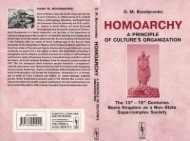L. Fituni, I. Abramova Resource Potential of Africa and Russia's ...
L. Fituni, I. Abramova Resource Potential of Africa and Russia's ...
L. Fituni, I. Abramova Resource Potential of Africa and Russia's ...
You also want an ePaper? Increase the reach of your titles
YUMPU automatically turns print PDFs into web optimized ePapers that Google loves.
coal mixture <strong>of</strong> a new generation. This is reported to be equivalent<br />
to liquid fuel.<br />
The former Soviet Union made attempts to develop liquefied<br />
coal <strong>and</strong> it even had a 300-kilometer-long liquefied coal pipeline in<br />
Siberia to supply fuel to a thermal power station. But this technology<br />
proved to be too costly since it consumes 150 kilowatt hours to<br />
make a ton <strong>of</strong> fuel. The new technology developed by “Kompomash”<br />
consumes only 20 kilowatt hours. Initially, coal is processed<br />
mechanically <strong>and</strong> chemically to upgrade its combustion reaction.<br />
Ordinary coal emits black smoke during combustion owing to<br />
unburned carbon black <strong>and</strong> dust, while liquefied coal burns completely<br />
<strong>and</strong> emits white smoke <strong>and</strong> does not pollute the environment<br />
with hard particles. The liquefied coal does not emit carbon monoxide<br />
at all, <strong>and</strong> the content <strong>of</strong> carbon black <strong>and</strong> nitrogen oxides in the<br />
residues <strong>of</strong> combustion is ten times less than minimum st<strong>and</strong>ards.<br />
This technology is competitive.<br />
South <strong>Africa</strong>n, US, or Chinese technologies are believed not<br />
to have achieved the same fine milling level as the Russian one<br />
(namely, a medium grain size <strong>of</strong> 0.7–0.8 microns). Consequently,<br />
there is no carbon dioxide emission since the fuel burns completely.<br />
Foreign technologies have failed to achieve this. Besides<br />
that, Russia uses advanced milling technology that consumes less<br />
energy.<br />
In 2010, in Tianjin, Russia’s “INTER RAO” Company <strong>and</strong><br />
China’s state-run “Shenhua” Corporation signed a memor<strong>and</strong>um on<br />
the construction <strong>of</strong> a factory to produce liquefied coal fuel in Russia.<br />
The factory will be build near the Chinese border <strong>and</strong> the company is<br />
exploring coal mines the products <strong>of</strong> which meet the technological<br />
dem<strong>and</strong>s. The cost <strong>of</strong> the factory is estimated at one billion U.S. dollars.<br />
47<br />
President Zuma’s visit to <strong>Russia's</strong> in August 2010 gave new impetus<br />
to bilateral cooperation. The delegation accompanying Mr.<br />
Zuma included 11 Ministers <strong>and</strong> over 100 business leaders. These<br />
interactions were critical for South <strong>Africa</strong>'s key domestic priorities,<br />
as well as for <strong>Russia's</strong> economic modernization <strong>and</strong> diversification<br />
policy priorities. During the 9th Joint South <strong>Africa</strong>n-Russian Inter-<br />
199







